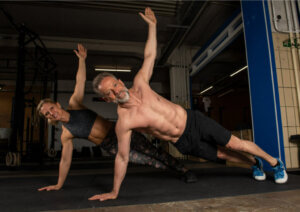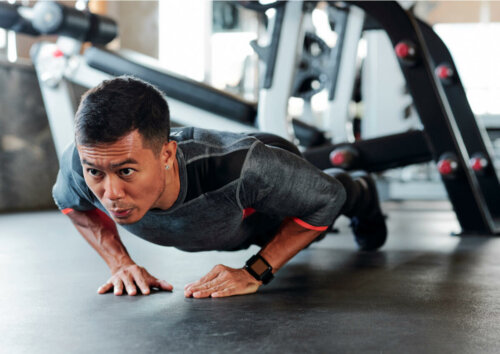Discover the Different Types of Push-Ups

Push-ups are an essential part of any workout routine due to their great benefits. They’re also very easy to do. However, their complexity varies depending on the type of push-up you decide to do. How many types of push-ups do you know about or do? In this article, we invite you to review your exercise routine to discover the types of push-ups you do and others you can add to your repertoire. Don’t miss it!
Types of push-ups
The goal of push-ups is to strengthen the muscles around the chest. Of these muscles, the muscle groups of the arms stand out, which must make the greatest effort during the exercise.
Most types of push-ups are executed in the prone position, meaning lying face down. The different types of push-ups have four supports: the feet and the palms of the hands.
However, said supports can vary according to the desired flexion. The idea, of course, isn’t to make incorrect movements that cause any joint or muscle injury.
Based on the above, we’ll now show you four types of push-ups you can do. We’ll also describe how to do them and how you can include them in your workout routine.
1. Diamond push-ups
They get their name because, when you do them, your hands make the shape of a diamond. To do a diamond push-up, join the thumbs and index fingers of each hand.

They must be at chest height, which requires more arm support. Thus, they’re more complex than other variations. This makes the triceps brachii and pectoralis major muscles work harder.
2. Asymmetrical push-ups
Also known as spartan push-ups, they’re usually characterized by hand support at different heights. One hand should go slightly above your head and the other at chest level.
It’s much more difficult than the diamond push-up. The hands should vary between push-ups; in each repetition, you need to change the support. This means that you should bring the hand that was above your head towards your chest and vice versa.
3. Tiger push-ups
This is one of the least known types of push-ups. They mostly work the triceps brachii.
The body supports itself on four body parts. However, the body should rest on the hands and forearms. This way, you perform a more complicated arm flexion and extension.

We recommend having well-strengthened upper limbs, especially the wrists and forearms, before trying it out. This way, you’ll be much less likely to suffer an injury due to overexertion.
4. “T” push-ups
They get their name due to the position the body adopts during their execution, which emulates the letter “T”. You have to start by lying face down and placing yourself on all fours. Support your body on your toes and palms of your hands.
This type of push-up is also often known as torso rotation, due to the movement performed. Firstly, do a common push-up by lowering your chest as close to the ground as possible. Then, lift your body.
The hand that stops supporting your body goes up while you rotate your torso until you form the letter “T” with your whole body, including the arms, as shown in the featured image of this article.
Include different types of push-ups in your routine
You can include the different types of push-ups in your workout routine as long as some areas of your body are well-strengthened. An alternative is to start with a few sets and repetitions. This way, your body adapts to the effort in a gradual and healthy way.
On the other hand, before including a push-up variation, we invite you to consult with a fitness expert. This specialist will be able to advise you in a timely manner regarding the intensity of the exercise, as well as how many reps you should do.
Push-ups are an essential part of any workout routine due to their great benefits. They’re also very easy to do. However, their complexity varies depending on the type of push-up you decide to do. How many types of push-ups do you know about or do? In this article, we invite you to review your exercise routine to discover the types of push-ups you do and others you can add to your repertoire. Don’t miss it!
Types of push-ups
The goal of push-ups is to strengthen the muscles around the chest. Of these muscles, the muscle groups of the arms stand out, which must make the greatest effort during the exercise.
Most types of push-ups are executed in the prone position, meaning lying face down. The different types of push-ups have four supports: the feet and the palms of the hands.
However, said supports can vary according to the desired flexion. The idea, of course, isn’t to make incorrect movements that cause any joint or muscle injury.
Based on the above, we’ll now show you four types of push-ups you can do. We’ll also describe how to do them and how you can include them in your workout routine.
1. Diamond push-ups
They get their name because, when you do them, your hands make the shape of a diamond. To do a diamond push-up, join the thumbs and index fingers of each hand.

They must be at chest height, which requires more arm support. Thus, they’re more complex than other variations. This makes the triceps brachii and pectoralis major muscles work harder.
2. Asymmetrical push-ups
Also known as spartan push-ups, they’re usually characterized by hand support at different heights. One hand should go slightly above your head and the other at chest level.
It’s much more difficult than the diamond push-up. The hands should vary between push-ups; in each repetition, you need to change the support. This means that you should bring the hand that was above your head towards your chest and vice versa.
3. Tiger push-ups
This is one of the least known types of push-ups. They mostly work the triceps brachii.
The body supports itself on four body parts. However, the body should rest on the hands and forearms. This way, you perform a more complicated arm flexion and extension.

We recommend having well-strengthened upper limbs, especially the wrists and forearms, before trying it out. This way, you’ll be much less likely to suffer an injury due to overexertion.
4. “T” push-ups
They get their name due to the position the body adopts during their execution, which emulates the letter “T”. You have to start by lying face down and placing yourself on all fours. Support your body on your toes and palms of your hands.
This type of push-up is also often known as torso rotation, due to the movement performed. Firstly, do a common push-up by lowering your chest as close to the ground as possible. Then, lift your body.
The hand that stops supporting your body goes up while you rotate your torso until you form the letter “T” with your whole body, including the arms, as shown in the featured image of this article.
Include different types of push-ups in your routine
You can include the different types of push-ups in your workout routine as long as some areas of your body are well-strengthened. An alternative is to start with a few sets and repetitions. This way, your body adapts to the effort in a gradual and healthy way.
On the other hand, before including a push-up variation, we invite you to consult with a fitness expert. This specialist will be able to advise you in a timely manner regarding the intensity of the exercise, as well as how many reps you should do.
All cited sources were thoroughly reviewed by our team to ensure their quality, reliability, currency, and validity. The bibliography of this article was considered reliable and of academic or scientific accuracy.
- Vossen, J. F., Kramer, J. E., Burke, D. G., & Vossen, D. P. (2000). Comparison of Dynamic Push-Up Training and Plyometric Push-Up Training on Upper-Body Power and Strength. Journal of Strength and Conditioning Research. https://doi.org/10.1519/00124278-200008000-00002
- Yang, J., Christophi, C. A., Farioli, A., Baur, D. M., Moffatt, S., Zollinger, T. W., & Kales, S. N. (2019). Association Between Push-up Exercise Capacity and Future Cardiovascular Events Among Active Adult Men. JAMA Network Open. https://doi.org/10.1001/jamanetworkopen.2018.8341
This text is provided for informational purposes only and does not replace consultation with a professional. If in doubt, consult your specialist.








